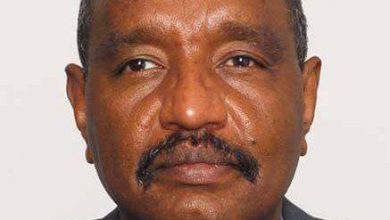Minister of Industry Mahasin Yaqoub in an interview to (Sudan Events ):

(3493) industrial facilities were damaged due to the war
Establishing industrial cities and zones takes (5) to (10) years
Reconstruction requires significant external funding
We are working on reviewing the fees imposed on goods in the states
We have an investment map for the manufacturing sector
Sudan Events-Interview – Nahid Oshi
Minister of Industry Mahasin Yaqoub revealed that (3493) industrial facilities were damaged due to the war, distributed between medium and large facilities in Khartoum state, while the number of workers in the damaged industrial facilities “large, medium and small” is estimated at more than (250,000 workers,she said that the extent of the destruction that occurred in the sector reaches about 90%.
She affirmed that the destruction and looting led to the loss of capital assets and production inputs. However, she affirmed that the process of rehabilitating the infrastructure of industrial zones requires concerted efforts, especially since establishing industrial cities and zones requires huge funding that extends over a number of years, usually taking between 5 to 10 years.
Many issues of the industrial sector were addressed in the following Interview .
What is the size of the losses in the industrial sector that occurred during the war?
There is no doubt that the war has affected all economic and residential sectors, including the industrial sector, but we expect that the greatest damage occurred in the industrial sector, as there was systematic destruction of all the infrastructure of the sector, including the destruction of buildings and the looting of property.
The looting and destruction also extended to include production lines, raw materials, ready-made and semi-finished production, and there was looting, plundering and destruction of all assets and property of the industrial sector.
What are your estimates of the cost of rebuilding the industrial sector?
The great damage that has befallen the industrial sector has not yet been quantified, but indicators
and from the vision of experts in the sector confirm that the extent of the damage that has befallen the industrial sector particularly in the two states of industrial weight “Khartoum and Gezira ” which represent more than 70% of
the size of the industrial sector facilities in Sudan, the damage is great and the destruction and looting have led to the loss of capital assets and production inputs and the impact extends to the workforce which has been displaced and many families have lost their source of income, as well as the economy has been damaged by the cessation of production of many industrial products with an economic and social impact, particularly essential goods such as medicines
and food products and others which require local and foreign expertise to accurately estimate the extent of the damage.
The number of industrial facilities in the states of Khartoum and Gezira ?
The number of industrial facilities damaged by the war is estimated at about (3,493) facilities distributed between medium and large facilities in Khartoum state. It is expected that more than 90% of them have been destroyed due to the war. The number of workers in the industrial facilities damaged by the war is estimated at more than (150,000) workers distributed between medium and large facilities. As for the small facilities that were counted in Khartoum state, it is expected that more than (100,000) workers have lost their sources of income due to the destruction of their facilities.
Tell us about the requirements for the reconstruction of the industrial sector and does reconstruction and construction require a longer time?
According to international experiences of countries affected by war, the reconstruction process
Requires concerted local and international efforts to provide the required funding for the reconstruction process.
There are also many financial and monetary policies required to implement the reconstruction process, especially in terms of bank financing, and the process of rehabilitating the infrastructure of industrial zones requires concerted efforts, especially since the establishment of industrial cities and zones requires huge funding that extends over a number of years, usually taking between 5 to 10 years.
Is there an investment map for the industrial sector?
Throughout its tenure, the Ministry has been preparing an investment map for the manufacturing sector, which contains a number of pieces of information that investors usually need in the process of making their investment decisions, in terms of providing information on natural and agricultural resources, as well as the geographical and sectoral distribution of industrial facilities, the design and actual capacities of these industries, as well as the comparative advantages enjoyed by each state and other information and data. The map also contains several summaries of feasibility studies for industrial investment projects whose raw materials are available in Sudan with a high economic return.
What is the Ministry’s plan to distribute industrial investment across the states?
The fact that the war that broke out on April 15, 2023 and is still raging has caused great destruction in the industrial sector, particularly with the concentration of industry in Khartoum state, which prompted a rethinking of the distribution of industrial investment in the states in a manner consistent with its production inputs in each state, and according to the comparative advantage of each state.
The investor has the right to choose the appropriate state while granting him preferential privileges from a plot of land for new projects and opening new markets to transport a large portion of the products, whether final or semi-finished, to be manufactured in other branches of the industrial facility and addressing the state governors urgently to facilitate the delivery of lands at encouraging prices without entering into disputes between the people over the ownership of these lands.
In addition to coordinating with the state governments and the General Administration of Customs to control the eastern and southern border crossings from which similar smuggled products are imported, which negatively affect the economy and the competitiveness of local products, and reviewing the fees imposed on goods in the states and examining the possibility of reducing them so that they are reasonable as service fees so as not to affect the price of the final product.
The witness is that each of the different states of Sudan has many comparative advantages, as the River Nile state is distinguished by its geographical location in terms of easy access to Port Sudan and the crossings.
There are many proposed investment projects such as leather tanning, leather industries, mining industries and meat processing.
The Northern state is also distinguished by its strategic location in terms of its proximity to both Egypt and Libya, with an investment map showing all industrial fields in the state, with a law to regulate and develop industry, but it suffers from weak bank financing for the sector and the lack of use of modern technologies in manufacturing processes, particularly for local products.
As for the Blue Nile state, it is one of the first states in the field of agricultural investment, as it has large areas for agriculture and livestock, in addition to contributing to the establishment of important food industries in addition to mineral wealth, and the presence of the Roseires Dam helps in providing the energy needed to establish industrial cities.
While Gedarif state is characterised by the presence of a legal fence that protects the investor and provides comparative advantages, the Red Sea state is characterized by the diversity of economic resources, and the White Nile state has large storage capacities and grain silos with a capacity of 100,000 tons, in addition to the presence of the railway presidency in the city of Kosti.
Is the state able to rebuild alone or does it require external support?
Reconstruction requires special financing conditions and the state has a major role in the reconstruction process.
However, this requires providing large external financing through international financing institutions.



